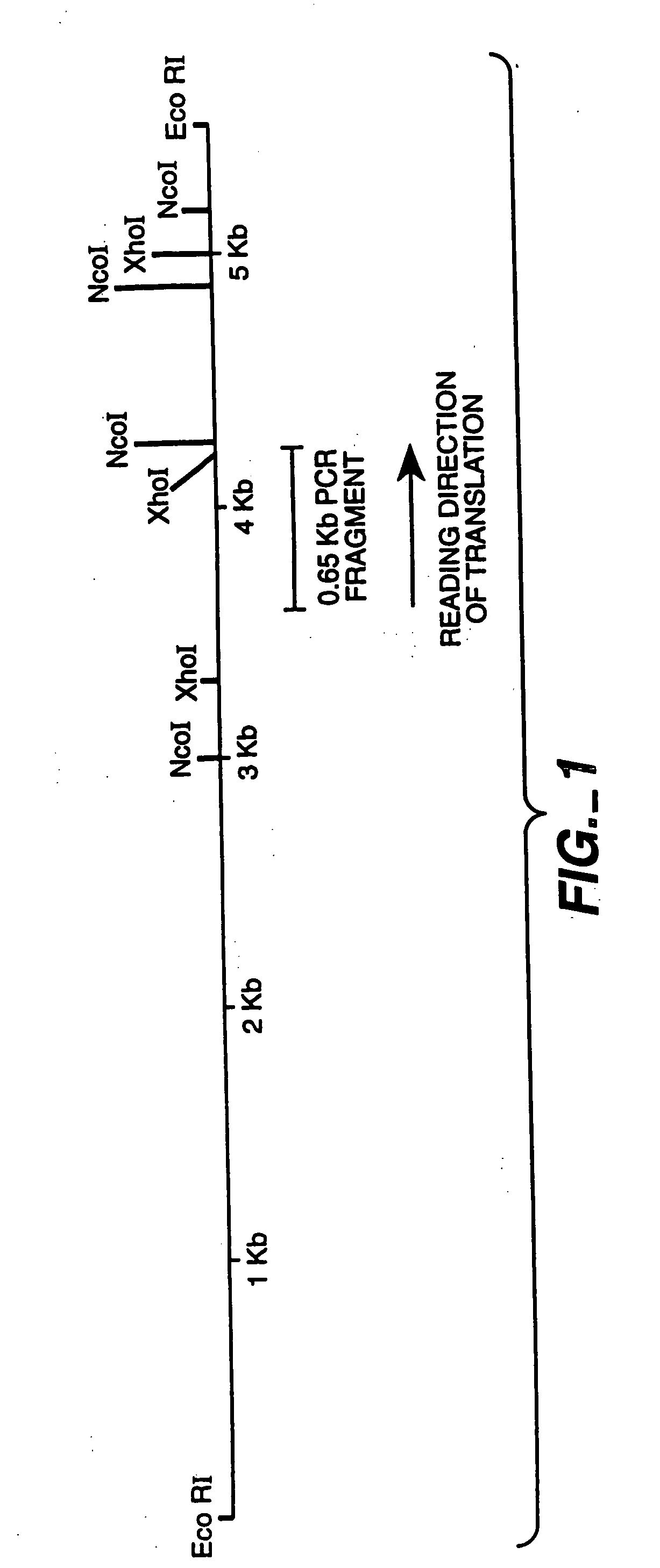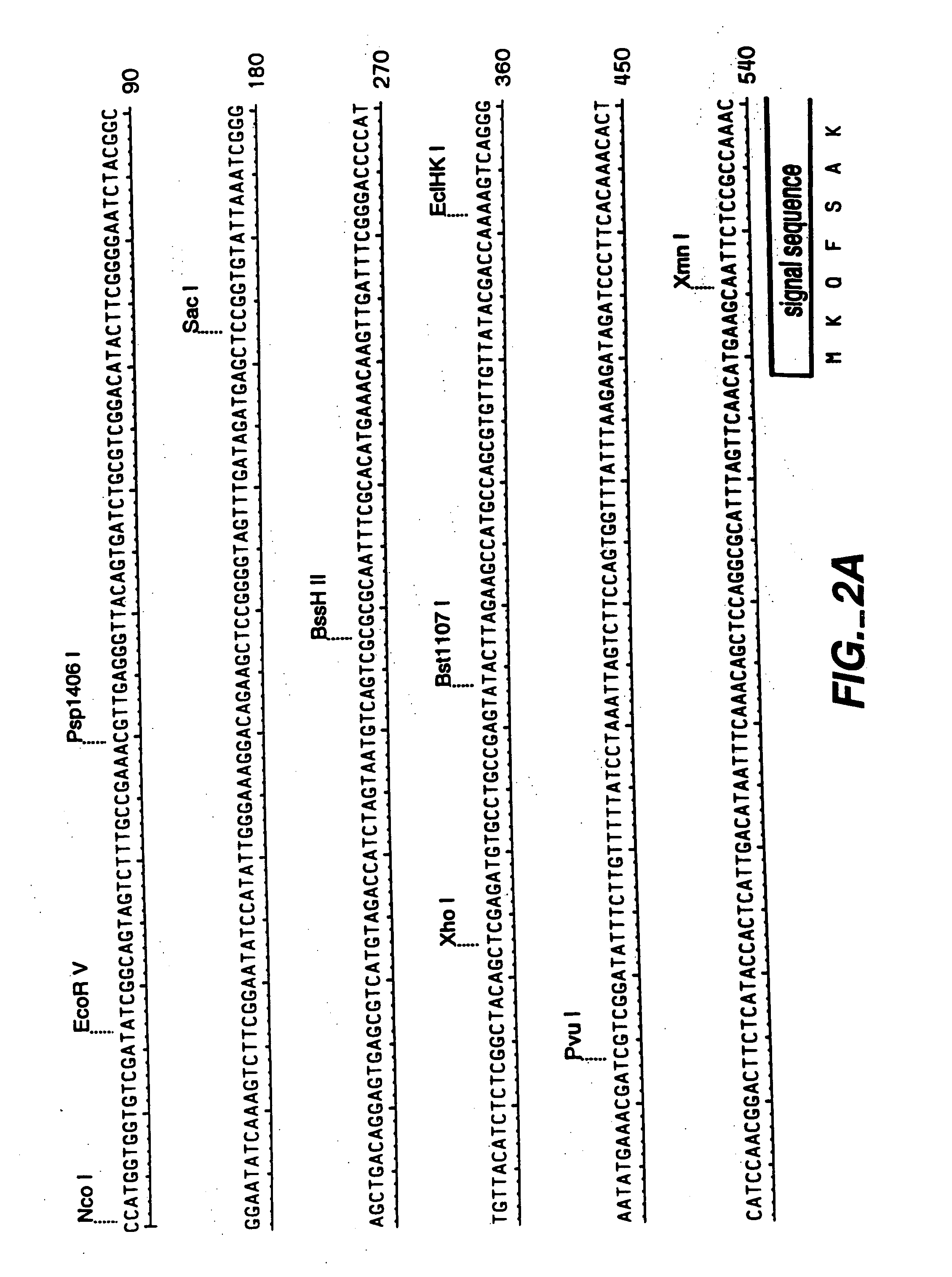Manipulation of the phenolic acid content and digestibility of plant cell walls by targeted expression of genes encoding cell wall degrading enzymes
a technology of which is applied in the field of manipulation of the phenolic acid content and digestibility of plant cell walls by targeting the expression of genes encoding cell wall degrading enzymes, can solve the problems of loss of nitrogen, protein and other nutrients being poorly utilized in the rumen, and not currently satisfying the demands of modern animal production, so as to enhance the availability of fermentable carbohydrates
- Summary
- Abstract
- Description
- Claims
- Application Information
AI Technical Summary
Benefits of technology
Problems solved by technology
Method used
Image
Examples
example 1
Preparation of Enzyme Encoding DNA Sequences
[0144] A genomic clone for FAE1 (see FIGS. 1-3) was used as the starting point for the preparation of an intronless FAE1 encoding DNA sequence. The sequence for the genomic clone is given in FIGS. 2 and 3. Separate fragments for both FAE exons were recovered by PCR from a 5.5 kb EcoRI fragment of the genomic clone in pLITMUS28, and ‘cDNA’ created by overlapping PCR. See FIG. 4.
[0145] Two 5′ primers were used. FAE-S5 which amplifies the entire reading frame (including the Aspergillus signal), and FAE-N5 which amplifies only the mature protein (i.e. has no signal). A number of codons are optimised (underlined in primer sequences below). The overlap product may be derived from either FAE-15 (wild type) or FAE-13 (conserved Ser changed to Ala) primers, allowing production of enzymatically inactive protein to check toxicity. As shown in FIG. 5, overlapping of PCR products made with FAE-15 and FAE-13 creates two possible uninterrupted reading ...
example 2
Preparation of Vectors
[0147] Vectors had the general structure shown in FIG. 6.
A. Plant Transformation Vector Series
[0148] Initial expression vectors were based on pCOR105 [rice actin promoter—McElroy et al. MGG 231:150-160 (1991)] (FIG. 7). pCOR105 Not and SstII sites were first destroyed [cut with NotI and SstI, followed by heat inactivation and T4 DNA polymerase treatment in the presence of dNTPs] using standard methods as described in Maniatis et al. or following the manufacturer's instructions for enzymes to simplify subsequent Not cassette manipulation and allow use of unique Sst site (see below).
[0149] The nos terminator from pMA406 (Ainley & Key (1990) PMB 14:949-60) was amplified by PCR using primers TER5 and TER3 to generate a fragment with the following sequence (SEQ ID NO:______):
(Pst1) (Not 1)AGACTGCAGACCATGGCGGCCGCGKAACCACTGAAGGATGAGCTGTAAAGAAGCAGATCGTTCAAACATTTGGCAATAAAGTTTCTTAAGATTGAATCCTGTTGCCGGTCTTGCGATGATTATCATATAATTTCTGTTGAATTACGTTAAGCATGTAATAATTAACATG...
example 3
[0205] Transformation of Plant Cells
[0206] Eight to ten weeks old embryogenic F. arundinacea and L. multiflorum suspension cultures were bombarded either with a single co-integration plasmid DNA vector containing FAE and hyg resistance genes, or with a co-transformation vector containing FAE and with plasmid pROB5 conferring hygromycin resistance (CAMV35S-hpt-nos) using a Particle Inflow Gun (PIG) (Finer et al. (1992) Development of the particle inflow gun for DNA delivery to plant cells Plant Cell Reports 11:323-328) and 1.5-3.0 μm gold particles as in Dalton et al (Dalton et al. (1999) Co-transformed diploid Lolium perenne (Perennial ryegrass), Lolium multiflorum (Italian ryegrass) and Lolium temulentum (Darnel) plants produced by microprojectile bombardment. Plant Cell Reports. 18: 721-726) and Kuai et al (Regeneration of fertile transgenic tall fescue (Festuca arundinacea) plants with a stable highly expressed foreign gene. Plant Cell Tissue and Organ Culture (1999) 58:149-154)...
PUM
| Property | Measurement | Unit |
|---|---|---|
| Digestibility | aaaaa | aaaaa |
Abstract
Description
Claims
Application Information
 Login to View More
Login to View More - R&D
- Intellectual Property
- Life Sciences
- Materials
- Tech Scout
- Unparalleled Data Quality
- Higher Quality Content
- 60% Fewer Hallucinations
Browse by: Latest US Patents, China's latest patents, Technical Efficacy Thesaurus, Application Domain, Technology Topic, Popular Technical Reports.
© 2025 PatSnap. All rights reserved.Legal|Privacy policy|Modern Slavery Act Transparency Statement|Sitemap|About US| Contact US: help@patsnap.com



